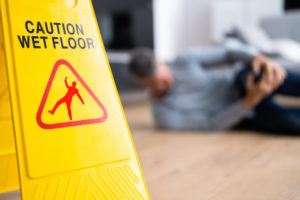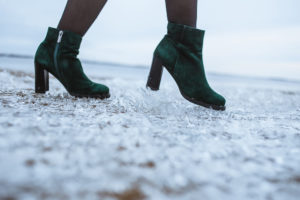On July 12, 2007, plaintiffs all across Michigan were given a small victory in the form of a favorable Court of Appeals decision. The case, Kaseta v Binkowski, No. 273215, Court of Appeals of Michigan, dealt with a plaintiff, Michele Kaseta, who went to the defendant’s home in the evening in order to execute a contract for the purchase of land. After finishing her business, Ms. Kaseta left the defendant’s home and walked down the driveway to her car. What she did not know, nor could have reasonably anticipated, was that the driveway was coated in black ice, causing her to slip and fall on her knee causing significant injury.
Ms. Kaseta testified that she did not notice the ice because it was dark and because the defendant’s did not have any outside lighting turned on. The Court of Appeals determined that Ms. Kaseta could not have observed the black ice upon casual inspection do to the lack of proper lighting, and held that she was entitled to have a jury hear her claim for liability and damages.
While this was a small victory in the never ending war against the insurance industry and the Open and Obvious danger doctrine, it was taken away completely on November 21, 2007, by the Michigan Supreme Court. In a brief written opinion, the Court reversed the Court of Appeals and ordered the Trial Court to dismiss the claim. The Court based its ruling on the reasoning set forth in the dissent to the original Court of Appeals decision, which is breathtaking in it’s brevity and callousness.
Judge Whitbeck noted in his dissent the application of the Open and Obvious danger doctrine to the facts of Ms. Kaseta’s claim. He stated on page 2 of his dissent:
An invitor has a common law duty to exercise reasonable care to warn or protect an invitee from an unreasonable risk of harm caused by a dangerous condition on the land. The basic duty to warn or protect an invitee does not generally include removal of open and obvious dangers. “‘Where the dangers are known to the invitee or are so obvious that the invitee might reasonably be expected to discover them, an invitor owes no duty to protect or warn the invitee unless he should anticipate the harm despite knowledge of it on behalf of the invitee.'” Determination whether a danger is open and obvious depends on whether it was reasonable to expect that an average person with ordinary intelligence would have discovered the danger upon casual inspection. The test is objective, and the court should look to whether a reasonable person in the plaintiff’s position would foresee the danger, not whether a particular plaintiff should have known that the condition was hazardous.
I find unpersuasive Kaseta’s claim that there was nothing to alert her to the possibility of ice on the Binkowskis’ driveway. First, the weather conditions on the day of Kaseta’s accident were such that a reasonable person would anticipate and foresee the possibility of ice on paved surfaces. Snow had fallen early on the day in question, followed by sunshine and warmer temperatures, which served to melt some of the snow. Then in the evening, temperatures dipped, causing melted snow to refreeze into ice. Kaseta, a life-long resident of Michigan, has had considerable experience with such weather. Kaseta even testified that she was aware that the temperature was dropping as the day progressed, and when she exited her car and walked up to the Binkowskis’ property, she observed that the street was wet and slushy. All of the paved areas around the Binkowskis’ house were clear of snow and ice, but there were mounds of shoveled snow on the Binkowskis’ lawn, adjacent to the driveway. Given the temperature fluctuations of the day, a reasonable person would note the possibility of ice forming on the driveway, particularly on the edges of the driveway which were adjacent to the snow. I believe, therefore, that a reasonable person in Kaseta’s position would anticipate or foresee that the Binkowskis’ driveway could be icy.
There are a few important lessons to take away from the above quoted text. First of all, if you have lived in Michigan for your entire life, or even for a considerable amount of time, it is your fault if you slip and fall on ice. No business or individual owes you any duty whatsoever to try and prevent you from falling on snow or ice, even if it is open and obvious. Basically, a business or home owner can see large formations of ice on their property and simply do nothing because the Michigan Supreme Court has abolished any claim of liability you may have against them.
Another lesson to take away from this ruling is that every person in Michigan is expected to be an expert on weather patterns on how that may cause icy conditions during winter. The decision does not even require the icy condition to be visible upon casual inspection, the single requirement of the Open and Obvious danger doctrine. Rather, a person is only required to anticipate or foresee a dangerous condition for it to be open and obvious. This completely ignores any deceptive or hidden aspects of a condition that can make it difficult or impossible to anticipate a dangerous condition.
But probably the most important lesson to learn from this decision is that you are on your own in Michigan, unless you own property or a business, then you are given complete protection from liability. It is disturbing to allow businesses and home owners to simply do nothing to prevent dangerous conditions from injuring persons on their property, and then at the same time blame the victim for becoming injured.
Just remember one thing, if you slip and fall on a snowy or icy condition in the state of Michigan, you have no one to blame but yourself according to the Michigan Supreme Court.
However, do not let this discourage you. If you, a member of your family, or a friend have been injured as a result of a slip and fall, we encourage you to contact an attorney using the form at the top of this page. Every situation is different and certain circumstances and facts can allow for compensation of your injuries as a result of a slip and fall.

The Grewal family has been serving the Mid-Michigan area for decades, and Grewal Law PLLC carries on that tradition of service and personal attention. Our attorneys quickly address your legal issues and strive to meet all attainable goals in an expeditious manner. When you walk through our door, we want you to feel confident that your legal needs can be met. We are proud to be a family law firm you can turn to again and again.














Comments for this article are closed.